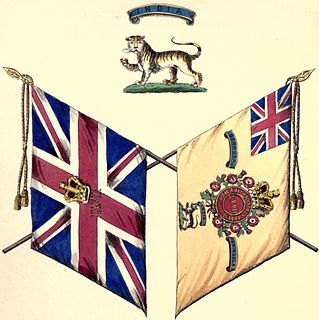The regular army of the British Army is listed according to an order of precedence for the purposes of parading. This is the order in which the various corps of the army parade, from right to left, with the unit at the extreme right being highest. Under ordinary circumstances, the Household Cavalry parades at the extreme right of the line. Militia and Army Reserve units take precedence after Regular units with the exception of The Honourable Artillery Company and The Royal Monmouthshire Royal Engineers.
The 78th Regiment, (Highland) Regiment of Foot also known as the 78th Fraser Highlanders was a British infantry regiment of the line raised in Scotland in 1757, to fight in the Seven Years' War. The 78th Regiment was one of the first three Highland Regiments to fight in North America.
The 38th Regiment of Foot was an infantry regiment of the British Army, raised in 1705. Under the Childers Reforms it amalgamated with the 80th Regiment of Foot to form the South Staffordshire Regiment in 1881.
The 65th Regiment of Foot was an infantry regiment of the British Army, raised in 1756 as the 2nd Battalion, 12th Regiment of Foot. Under the Childers Reforms it amalgamated with the 84th Regiment of Foot to become the 1st Battalion, York and Lancaster Regiment in 1881.
The 84th Regiment of Foot was a British regiment raised for service in India with the British East India Company.
The 51st, or Pepperrell's Regiment of Foot was a British Army regiment first raised in 1754.
The 50th, or Shirley's Regiment of Foot was a British Army regiment first raised in 1745.
The 135th (Limerick) Regiment of Foot was an infantry regiment of Fencibles in the British Army, created and promptly disbanded in 1796. The regiment, raised by Sir Vere Hunt, did not see any active service; it served solely to recruit soldiers. On disbandment, the recruits were drafted into other regiments. The regiment has the interesting historical distinction of having had the highest regimental number of any British line regiment.

The 67th Regiment of Foot was a line infantry regiment of the British Army, raised in 1756. Under the Childers Reforms it amalgamated with the 37th Regiment of Foot to form the Hampshire Regiment in 1881.
The 61st Regiment of Foot was an infantry regiment of the British Army, raised in 1756. Under the Childers Reforms it amalgamated with the 28th Regiment of Foot to form the Gloucestershire Regiment in 1881.
The 87th Regiment of Foot was a Scottish infantry regiment in the British Army, formed in 1759 and disbanded in 1763.
Three regiments of the British Army have been numbered the 58th Regiment of Foot:
The 75th Regiment of Foot (Invalids) was an infantry regiment of the British Army from 1762 to 1768. It was originally raised as a regiment of invalids in June 1762, by John Lind, and numbered the 118th Foot; it was renumbered as the 75th the following year, and disbanded in 1768 or 1769.
The 108th Regiment of Foot was an infantry regiment of the British Army from 1761 to 1763. It was raised in October 1761 from a cadre of the 31st Regiment of Foot, and was disbanded in 1763.
The 59th Regiment of Foot was an infantry regiment of the British Army, formed in 1755 in response to the threat of renewed war with France. Under the Childers Reforms it amalgamated with the 30th (Cambridgeshire) Regiment of Foot to form the East Lancashire Regiment in 1881.
The 62nd (Wiltshire) Regiment of Foot was an infantry regiment of the British Army, which was raised in 1756 and saw service through the eighteenth and nineteenth centuries. Under the Childers Reforms it amalgamated with the 99th (Lanarkshire) Regiment of Foot to form the Wiltshire Regiment in 1881.
Four regiments of the British Army have been numbered the 61st Regiment of Foot:
The 76th Regiment of Foot , sometimes referred to as 'MacDonnell's Highlanders' after its colonel, John MacDonnell of Lochgarry, was a Scottish Light Infantry regiment raised in the west of Scotland and western isles of Scotland in 1777.
The 76th Regiment of Foot was a regiment of the British Army from 1756 to 1763.
The 73rd Regiment of Foot was a regiment in the British Army from 1758 to 1763. It was formed on 28 April 1758 from the 2nd Battalion of the 34th Regiment of Foot, and served in Ireland until it was disbanded in 1763.
This page is based on this
Wikipedia article Text is available under the
CC BY-SA 4.0 license; additional terms may apply.
Images, videos and audio are available under their respective licenses.
